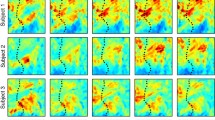Abstract
Nine cases of relatively selective hand weakness produced by stroke were analyzed to examine the degree to which representations of different fingers are segregated in the human primary motor cortex (M1). In five cases, all the digits were involved uniformly; in four cases the radial versus ulnar digits of the hand were involved differentially. No patient showed discrete involvement of a single digit, nor did any patient have greatest weakness in the index, middle or ring finger. These findings provide little evidence that each digit is represented in a separate cortical territory, but rather suggest that broadly overlapping gradients – with the radial digits somewhat more heavily represented laterally and the ulnar digits somewhat more heavily represented medially – are superimposed on an underlying organization in which control of each finger is distributed widely throughout the human M1 hand area.
Similar content being viewed by others
Author information
Authors and Affiliations
Additional information
Received: 3 August 1998 / Accepted: 7 January 1999
Rights and permissions
About this article
Cite this article
Schieber, M. Somatotopic gradients in the distributed organization of the human primary motor cortex hand area: evidence from small infarcts. Exp Brain Res 128, 139–148 (1999). https://doi.org/10.1007/s002210050829
Issue Date:
DOI: https://doi.org/10.1007/s002210050829




